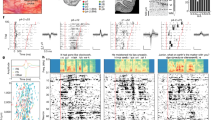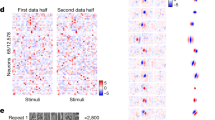Abstract
The accuracy with which listeners can locate sounds is much greater than the spatial sensitivity of single neurons1,2,3. The broad spatial tuning of auditory neurons indicates that a code based on the responses of ensembles of neurons, a population code, must be used to determine the position of a sound in space. Here we show that the tuning of neurons to the most potent localization cue, the interaural time difference in low-frequency signals (<∼2 kHz; refs 4, 5), becomes sharper as the information ascends through the auditory system. We also show that this sharper tuning increases the efficiency of the population code, in the sense that fewer neurons are required to achieve a given acuity.
This is a preview of subscription content, access via your institution
Access options
Subscribe to this journal
Receive 51 print issues and online access
$199.00 per year
only $3.90 per issue
Buy this article
- Purchase on Springer Link
- Instant access to full article PDF
Prices may be subject to local taxes which are calculated during checkout



Similar content being viewed by others
References
Mills, A. W. On the minimum audible angle. J. Acoust. Soc. Am. 65, 991–1000 (1958).
Kuwada, S., Batra, R. & Fitzpatrick, D. C. in Binaural and Spatial Hearing in Real and Virtual Environments(eds Gilkey, R. H. & Anderson, T. R.) 399–426 (Erlbaum, Mahwah, NJ, (1997)).
Brugge, J. F., Reale, R. A. & Hind, J. E. in Binaural and Spatial Hearing in Real and Virtual Environments(eds Gilkey, R. H. & Anderson, T. R.) 447–474 (Erlbaum, Mahwah, NJ, (1997)).
Blauert, J. Spatial Hearing: The Psychophysics of Human Sound Localization(MIT Press, Cambridge, MA, (1982)).
Wightman, F. L. & Kistler, D. J. The dominant role of low frequency interaural time differences in sound localization. J. Acoust. Soc. Am. 91, 1648–1661 (1992).
Yin, T. C. T. & Kuwada, S. Binaural interaction in low-frequency neurons in inferior colliculus of the cat. III. Effects of changing frequency. J. Neurophysiol. 50, 1020–1042 (1983).
Li, L. & Kelly, J. B. Inhibitory influence of the dorsal nucleus of the lateral lemniscus on binaural responses in the rat's inferior colliculus. J. Neurosci. 12, 4530–4539 (1992).
Stern, R. M. & Trahiotis, C. in Auditory Physiology and Perception(eds Cazals, Y., Horner, K. & Demany) 547–554 (Pergamon, Oxford, (1992)).
Georgopoulos, A. P., Schwartz, A. B. & Kettner, R. E. Neuronal population coding of movement direction. Science 233, 1416–1419 (1986).
Georgopoulos, A. P., Kettner, R. E. & Schwartz, A. B. Primate motor cortex and free arm movements to visual targets in three-dimensional space. II. Coding of the direction of movement by a neuronal population. J. Neurosci. 8, 2928–2937 (1988).
Stern, R. M. & Colburn, H. S. Theory of binaural interaction based on auditory-nerve data IV. A model for subjective lateral position. J. Acoust. Soc. Am. 64, 127–140 (1978).
Green, D. M. & Swets, J. A. in Signal Detection Theory and Psychophysics 1–455 (Wiley, New York, (1966)).
Hinton, G. E., McClelland, J. L. & Rummelhart, D. E. in Parallel Distributed Processing Vol. I(eds Rummelhart, D. E. & McClelland, J. L.) 77–109 (MIT Press, Cambridge, MA, (1986)).
Salinas, E. & Abbot, L. F. Vector reconstruction from firing rates. J. Comp. Neurosci. 1, 89–97 (1994).
Heffner, H. & Masterton, B. Hearing in Glires: domestic rabbit, cotton rat, feral house mouse, and kangaroo rat. J. Acoust. Soc. Am. 68, 1584–1599 (1980).
Hafter, E. R. & DeMaio, J. Difference thresholds for interaural delay. J. Acoust. Soc. Am. 57, 181–187 (1975).
Hubel, D. H. & Wiesel, T. N. Receptive fields. Binocular interactions and functional architecture in the cat's visual cortex. J. Physiol. (Lond.) 160, 106–154 (1962).
Capuano, U. & McIlwain, J. T. Reciprocity of receptive field images and point images in the superior colliculus of the cat. J. Comp. Neurol. 196, 13–23 (1981).
Rummelhart, D. E., Smolensky, P., Hinton, G. E. & McClelland, J. L. in Parallel Distributed Processing Vol. II(eds McClelland, J. L. & Rummelhart, D. E.) 77–109 (MIT Press, Cambridge, MA, (1986)).
Van Gisbergen, J. A. M., Van Opstal, A. J. & Tax, A. A. Collicular ensemble coding of saccades based on vector summation. Neuroscience 21, 541–555 (1987).
Lee, C., Rohrer, W. H. & Sparks, D. L. Population coding of saccadic eye movements by neurons in the superior colliculus. Nature 332, 357–360 (1988).
Theunissan, F. & Miller, J. P. Representation of sensory information in the cricket cercal sensory systems. II, Information theoretic calculation of system accuracy and optimal tuning curve widths of four primary interneurons. J. Neurophysiol. 66, 1690–1703 (1991).
Perrott, D. R. Concurrent minimum audible angle: a re-examination of the concept of auditory spatial acuity. J. Acoust. Soc. Am. 75, 1201–1206 (1984).
Trahiotis, C. & Bernstein, C. R. Detectability of interaural delays over select spectral regions: Effects of flanking noise. J. Acoust. Soc. Am. 87, 810–913 (1990).
Dye, R. H. The combination of interaural information across frequencies: Lateralization of the basis of interaural delay. J. Acoust. Soc. Am. 88, 2159–2170 (1990).
Heller, L. M. & Trahiotis, C. Extents of laterality and binaural interference effects. J. Acoust. Soc. Am. 99, 3632–3637 (1996).
Kuwada, S., Stanford, T. R. & Batra, R. Interaural phase sensitive units in the inferior colliculus of the unanesthetized rabbit. Effects of changing frequency. J. Neurophysiol. 57, 1338–1360 (1987).
Batra, R., Kuwada, S. & Stanford, T. R. Temporal coding of envelopes and their interaural delays in the inferior colliculus of the unanesthetized rabbit. J. Neurophysiol. 61, 257–268 (1989).
Batra, R., Kuwada, S. & Fitzpatrick, D. C. Sensitivity to interaural temporal disparities of low and high frequency neurons in the superior olivary complex. I. Heterogeneity of responses. J. Neurophysiol.(in the press).
Stanford, T. R., Kuwada, S. & Batra, R. Acomparison of the interaural time sensitivity of neurons in the inferior colliculus and thalamus of the unanesthetized rabbit. J. Neurosci. 12, 3200–3216 (1992).
Acknowledgements
We thank C. Trahiotis, L. Bernstein and L. Abbott for discussion, L. M. Seman for technical assistance, and T. Ju and R. Manfredi for computer programming. This work was supported by a grant from the Center for Deafness and Communicative Disorders, NIH, USA.
Author information
Authors and Affiliations
Corresponding author
Rights and permissions
About this article
Cite this article
Fitzpatrick, D., Batra, R., Stanford, T. et al. A neuronal population code for sound localization. Nature 388, 871–874 (1997). https://doi.org/10.1038/42246
Received:
Accepted:
Issue Date:
DOI: https://doi.org/10.1038/42246
This article is cited by
-
Unsupervised approach to decomposing neural tuning variability
Nature Communications (2023)
-
Neural Representations Beyond “Plus X”
Minds and Machines (2018)
-
Model predictions of features in microsaccade-related neural responses in a feedforward network with short-term synaptic depression
Scientific Reports (2016)
-
The Interaural Time Difference Pathway: a Comparison of Spectral Bandwidth and Correlation Sensitivity at Three Anatomical Levels
Journal of the Association for Research in Otolaryngology (2014)
-
Responses of Cat Auditory Cortex to Signal Localizing Characteristics in Conditions of Electrical Stimulation of the Auditory Nerve and Sound Stimulation
Neuroscience and Behavioral Physiology (2013)
Comments
By submitting a comment you agree to abide by our Terms and Community Guidelines. If you find something abusive or that does not comply with our terms or guidelines please flag it as inappropriate.



